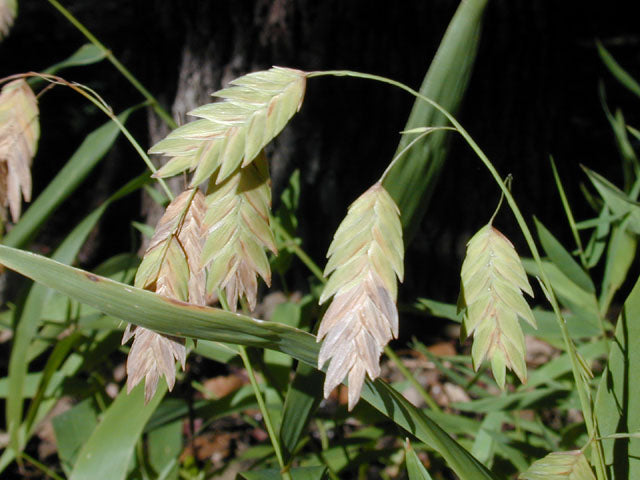Inland Sea Oats (Chasmanthium latifolium)
Inland Sea Oats (Chasmanthium latifolium)
Low stock: 10 left
Couldn't load pickup availability
Chasmanthium latifolium (Michx.) Yates
Inland Sea Oats, Indian Wood Oats, Wild Oats, River Oats, Flathead Oats, Upland Oats, Upland Sea Oats
Poaceae (Grass Family)
Synonym(s): Uniola latifolia
USDA Symbol: CHLA5
This is a 2-4 ft., clump-forming, perennial grass bearing large, drooping, oat-like flower spikelets from slender, arching branches. The blue-green, bamboo-like leaves often turn a bright yellow-gold, especially in sunnier sites, in fall.
Very popular as a low-maintenance shade grass, Inland sea oats is notable for its large, graceful seedheads. Sending up blue-green basal leaves in earliest spring, it can be 2 feet tall and a vivid green by May, with translucent green seedheads swaying in the breeze. By mid-summer, the seeds will have turned an attractive ivory and will turn brown in a few months before dropping off. It passes through most of winter a soft brown, but becomes tattered and gray by February, a good time to cut it back to the basal rosette. It reseeds easily and can expand aggressively within a couple of years, making a solid mat in moist loams. It has been used to prevent soil erosion along streams. The seed stalks are attractive in flower arrangements.
Plant Characteristics
Habit: Grass/Grass-like
Root Type: Fibrous
Leaf Retention: Deciduous
Leaf Arrangement: Alternate
Leaf Complexity: Simple
Leaf Venation: Parallel
Inflorescence: Spikelet
Fruit Type: Caryopsis
Size Notes: 2 to 4 feet tall
Leaf: Green
Fruit: Tan
Bloom Time: Jun , Jul , Aug , Sep
Distribution
USA: AL , AR , AZ , DC , DE , FL , GA , IA , IL , IN , KS , KY , LA , MD , MI , MO , MS , NC , NJ , NM , OH , OK , PA , SC , TN , TX , VA , WI , WVNative Distribution: Eastern North America, from PA south to n. FL, west as far as s. IL, e. KS, and central TX and south to Nuevo Leon in northeastern Mexico
Native Habitat: Shaded slopes; low thickets; stream banks
Growing Conditions
Water Use: MediumLight Requirement: Part Shade , Shade
Soil Moisture: Moist
Soil pH: Acidic (pH<6.8)
CaCO3 Tolerance: Low
Soil Description: Moist sands, loams, and clays. Poorly drained okay.
Conditions Comments: Avoid planting in continuous full sun, as its leaves turn yellowish without adequate shade. The more water it receives, the more tolerant it will be of intense sun, but it still prefers shade.
Benefit
Use Ornamental: An attractive, dense-covering grass for shade, with decorative seedheads. Also good in pots.Use Wildlife: Seeds eaten by small mammals and granivorous birds. Leaves provide graze for mammals. Stems and leaves used as nesting material by birds.
Use Other: Cut seed stalks decorative in dried arrangements.
Interesting Foliage: yes
Attracts: Butterflies
Larval Host: Pepper & salt skipper butterfly, Bell's road side skipper butterfly, Bronzed roadside skipper butterfly
Deer Resistant: High
Value to Beneficial Insects
Provides Nesting Materials/Structure for Native BeesThis information was provided by the Pollinator Program at The Xerces Society for Invertebrate Conservation.
https://www.wildflower.org/plants/result.php?id_plant=CHLA5
Image Information
Photographer: Marcus, Joseph A.City: Austin
County: Travis
State: TX
Location Notes: Lady Bird Johnson Wildflower Center.
Accession date: 2003-09-15
Filename: 6151_IMG00300.JPG
Slide Index: Not Applicable
Restrictions: Unrestricted
Collection: Wildflower Center Digital Library
Original Format: Digital
Orientation: Landscape
Shot: Flower(s)
Date Taken: 2003
NPIN Image Id: 12453


